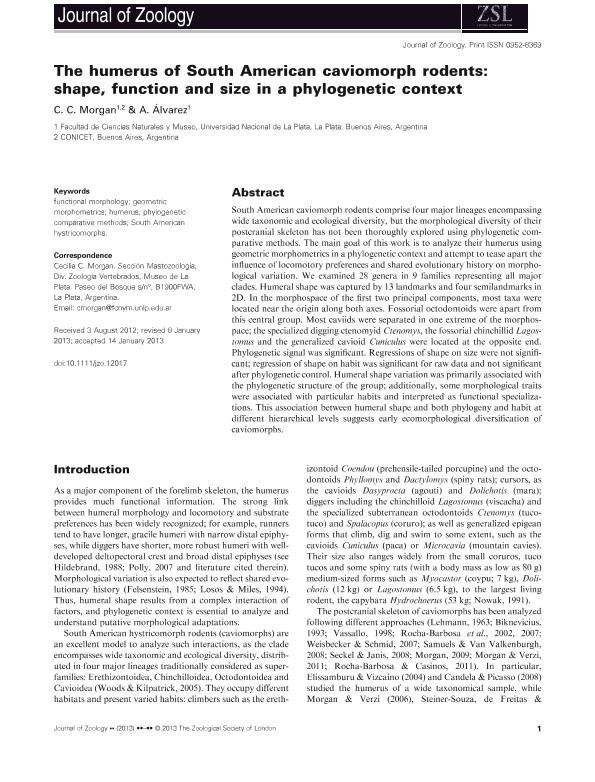Artículo
The humerus of South American caviomorph rodents: Shape, function and size in a phylogenetic context
Fecha de publicación:
06/2013
Editorial:
Wiley Blackwell Publishing, Inc
Revista:
Journal Of Zoology
ISSN:
0952-8369
Idioma:
Inglés
Tipo de recurso:
Artículo publicado
Clasificación temática:
Resumen
South American caviomorph rodents comprise four major lineages encompassing wide taxonomic and ecological diversity, but the morphological diversity of their postcranial skeleton has not been thoroughly explored using phylogenetic comparative methods. The main goal of this work is to analyze their humerus using geometric morphometrics in a phylogenetic context and attempt to tease apart the influence of locomotory preferences and shared evolutionary history on morphological variation. We examined 28 genera in 9 families representing all major clades. Humeral shape was captured by 13 landmarks and four semilandmarks in 2D. In the morphospace of the first two principal components, most taxa were located near the origin along both axes. Fossorial octodontoids were apart from this central group. Most caviids were separated in one extreme of the morphospace; the specialized digging ctenomyid Ctenomys, the fossorial chinchillid Lagostomus and the generalized cavioid Cuniculus were located at the opposite end. Phylogenetic signal was significant. Regressions of shape on size were not significant; regression of shape on habit was significant for raw data and not significant after phylogenetic control. Humeral shape variation was primarily associated with the phylogenetic structure of the group; additionally, some morphological traits were associated with particular habits and interpreted as functional specializations. This association between humeral shape and both phylogeny and habit at different hierarchical levels suggests early ecomorphological diversification of caviomorphs.
Archivos asociados
Licencia
Identificadores
Colecciones
Articulos(CCT - LA PLATA)
Articulos de CTRO.CIENTIFICO TECNOL.CONICET - LA PLATA
Articulos de CTRO.CIENTIFICO TECNOL.CONICET - LA PLATA
Citación
Morgan, Cecilia Clara; Alvarez, Alicia; The humerus of South American caviomorph rodents: Shape, function and size in a phylogenetic context; Wiley Blackwell Publishing, Inc; Journal Of Zoology; 290; 2; 6-2013; 107-116
Compartir
Altmétricas




